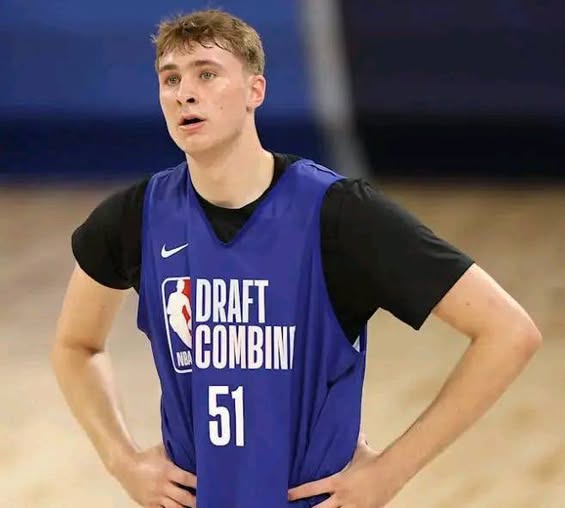In a seismic shake‑up of the NBA offseason landscape, the Duke Blue Devils have emerged as the frontrunner in the high‑stakes chase for Miami Heat sharpshooter Tyler Herro, the $76 million guard whose emergence over the past few seasons has made him one of the most talked‑about young scorers in the league. Sources deep inside NBA circles confirm that Duke, long a powerhouse of collegiate basketball, is now seriously positioning itself to bring Herro into a blockbuster deal designed not only to upgrade the Blue Devils’ backcourt but also to center their future plans around the electrifying talent of rising sophomore phenom “Copper,” projected as their next generational centerpiece.
Herro, 23, exploded onto the scene after being selected Miami’s first‑round pick in 2019. Averaging well over 20 points per game last season, he established himself as a three‑level scorer capable of creating his own shot and draining it from all areas of the floor. Combine that with strong playmaking and undeniable confidence, and you have a modern offensive weapon tailor‑made for Duke’s up‑tempo, star‑centric system. Miami, meanwhile, finds itself in a delicate cap situation: their core of Jimmy Butler, Bam Adebayo, and Tyler Herro now commands significant financial commitments, and with frontcourt depth thinning and cap flexibility strained, they’ve made no secret of their willingness to consider bold moves to reshape their roster. That’s where Duke enters the picture with a compelling offer.
The proposed deal would send Herro to Durham in exchange for Duke’s prized young backcourt talent known simply as Copper—a nickname blurting on national radar after he exploded for 18.5 points, 6 assists, and 5 rebounds per game as a freshman, earning ACC Rookie of the Year honors. Copper’s blend of size, playmaking, and two‑way potential has Blue Devils coaches and scouts convinced he could be the face of the program for years. The plan, insiders say, is simple: make Copper the foundational piece, then add proven scoring punch in the form of Herro to elevate Duke into title contender territory immediately.
From Miami’s perspective, the deal offers flexibility. While Herro’s value is sky‑high, his skill set overlaps with existing backcourt pieces like Tyler Herro himself, Duncan Robinson, and Terry Rozier. The Heat’s projected core next season—Butler, Adebayo, Herro, Rozier and Robinson—lacks a true playmaking dynamo. Copper, by contrast, is viewed as a dynamic floor general with shot‑creation ability and defensive versatility. In essence, Miami would be trading a ‘tweener’ scorer for a younger, more versatile guard who could grow alongside or even be the eventual successor to Butler or Adebayo in a couple of years—while also creating valuable cap space should Butler or Bam explore future free agency options or player‑option decisions.
That said, pulling off this blockbuster won’t be easy. Herro is under contract with a hefty cap hit this season and next, and Duke would have to offer a package rich enough in talent or picks to make the swap palatable. The rumored package includes multiple first‑round picks, potential upside talent, and a pay‑roll structure that brings the timing into flush alignment: Copper’s rookie deal still has strong years left on it, and Duke would be able to parlay Herro’s on‑court production and marketability into a revenue and recruitment boost from day one. Meanwhile, Miami retains financial maneuverability and a younger lead guard of the future.
The timing could hardly be more dramatic. Herro, fresh off an impressive third season that culminated in an Eastern Conference playoff appearance—one where he averaged better than 20 points over a hot stretch—has matured into a franchise player. But he’s also in the sweet spot of leverage: locked in for now, but projecting to command maximum money down the line. His future with the Heat depends partly on how Miami navigates its luxury‑tax constraints and cap structure. If adding Copper clears room to chase another impact star or retain frontcourt depth, GM Pat Riley is ready to pull the trigger.
In Durham, Blue Devils head coach Jon Scheyer isn’t hiding his dream: resurrect the national championship quest with a one‑two punch of Copper and Herro. Bringing a legitimate pro-level scorer into the fold would send shockwaves through the NCAA. Add a coach who already has pedigree under Coach K and a system designed around two elite guards—and it becomes the blueprint for instant competitiveness. Duke’s backcourt would suddenly match or surpass any in college basketball, thanks to Copper’s playmaking and defensive acumen complemented by Herro’s pure scoring and experience.
Premium recruits and national media attention would be immediate side‑effects. Blue Devils boosters, ever eager for Broadway, know that the incoming Herro factor would elevate Duke’s recruiting pitch from “come build with us” to “join a pro‑ready powerhouse.” And make no mistake: college athletics are in the business of spotlight, and Herro—already a shine in NBA marketing campaigns—would bring a rare combination of polish, flair, and scoring credentials. For Copper, playing alongside Herro could act as a turbocharger for his draft stock. And for Scheyer, it’s validation that his recruiting momentum and system identity can rival the biggest names in the game, even with NCAA recruiting rules tightening.
All that said, Miami has bargaining chips of its own. Herro’s stock is high—he’s young, nationally recognizable, married to a rising social media empire, and still has untapped upside if he can refine his defense and shot selection. Unless Duke can overpay or present a pitch Miami can’t refuse (some are speculating on draft capital through 2027 plus young talent), it could boil down to leverage: would Miami rather use Herro as a foundational piece and reroute their long‑term blueprint around him and Butler? Or pivot preemptively toward financial flexibility and a younger core anchored by Copper?
One source close to Miami’s front office, speaking anonymously, said, “We want to win now, but not at the expense of being financially trapped. If we can find a floor‑general who fits our culture and frees up runway down the line, that’s worth exploring.” The phrasing here is telling: design, culture, timing—they’re shaping this as more than a typical trade. It’s a philosophical turn.
Fans across the country are already buzzing. Duke Nation is lighting up message boards and forums with #HerroToDurham posts, while Heat faithful are bracing for the potential of losing a fan favorite. Social analysts note Herro’s social media metrics are some of the highest among nba guards under 25—meaning there’s a brand equity component too. Bringing that into a college brand—especially Duke—would be unprecedented. But bringing Copper to Miami in her stead is also a narrative: investing in long‑term developmental upside while clearing financial runway.
What comes next? League insiders expect conversations to intensify through the summer. Both sides are reportedly in communication with agents and financial advisors to model the deal’s cap ramifications, NCAA eligibility rules, and public messaging strategies. Duke is already planning a media rollout: a joint “statement of intent” that would spotlight the two young guards’ chemistry potential and alignment with Scheyer’s vision for a modern, guard‑led identity.
Miami, meanwhile, is quietly preparing counter‑offers. Names like Davion Mitchell, De’Anthony Melton, and even draft pick combinations are being floated as alternative stabilizers. The message: if Duke wants Herro, they’ll need to pony up more than one measly first‑rounder. Pat Riley is said to be pushing back on demands without the commitment of at least two high first‑round picks—one for the 2025 draft, one for 2026—plus a promising young player to balance the deal.
Duke’s pitch to Copper is also aggressive. They’re preparing a meal plan, dorm upgrades, academic support, NIL opportunity previews, and hometown visits to show him he can remain in Durham for another year or two and still prep for the NBA spotlight. The optics of two elite guards learning under Scheyer next to Duke’s storied legacy is magnetic—even as the professional route beckons.
For Herro, this is a career‑defining moment. Does he stay Miami’s built‑in go‑to scorer with guaranteed playoff runs? Or does he pivot to a college–NBA hybrid that defies expectation and potentially propels him to even bigger things in the pros? His family and agent are reportedly weighing both paths. Duke’s allure is strong—but so are Miami’s winning reputation and NBA continuity.
One thing is clear: this is more than a trade rumor. It’s a strategic chess match between pro ambition and educational tradition, between roster building and financial maneuvering. For Duke to land Herro would rewrite college basketball’s transfer and talent equation. For Miami to reshape itself around Copper would signal a generational pivot.
Over the next few weeks, eyes will be firmly on team war rooms in Miami and Duke. The Sign‑and‑Trade window opens in July. Formal meetings between coaches, executives, and agents are expected. If rumors are correct, initial “feelers” have already come across the table in early June. Expect public posturing: a Duke booster quoted anonymously as saying, “We’ve got the receipts—both talent and cash. We just need Herro’s SAY‑SO,” while a Heat spokesperson released the standard placeholder statement, “We remain committed to exploring all options that best position our long‑term future.”
At this point, no one is counting Herro out entirely. But Copper’s story has real momentum. Unless Miami matches Duke’s offer in flexibility, picks, or cash value, Copper may already be the guard around whom the Heat will build over the next decade. And Miami fans will wonder if letting go of a consistent 20‑point scorer in Herro was the right risk.
Because make no mistake: this is far more than just a player swap. It’s a recalibration of franchise identities. Duke wants Herro to affirm its return to national dominance. Miami wants Copper to affirm its transition from short‑term contender to sustainable contender. Both need guard leadership to drive the shift. And unless one side blinks, the narrative is set for a summer of bold gambles and headline moments.
In the end, the question asking point becomes this: what weighs more—Herro’s proven scoring punch, or Copper’s potential for long‑term control, culture, and financial upside? One answer likely lies in the next round of negotiations. But whichever path they choose, it will echo far beyond the backcourt—rewriting trajectories, reigniting narratives, and answering once and for all which guard Duke and Miami truly want as their next face-of-the‑franchise.



